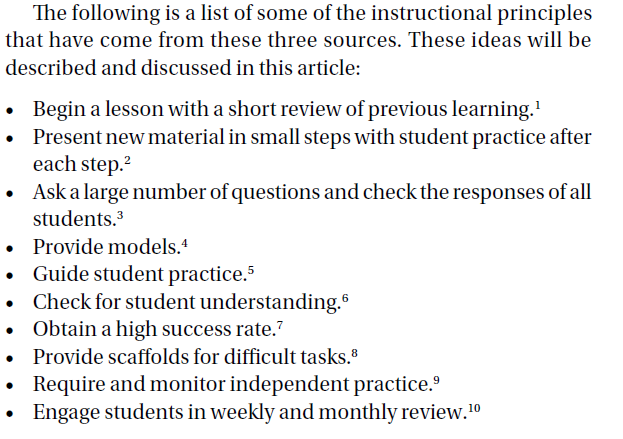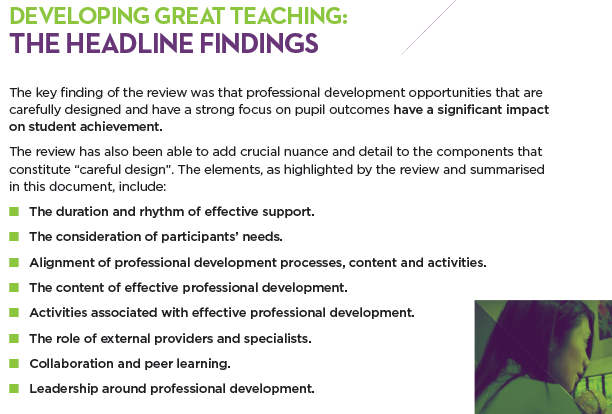I first wrote this post over two years ago. In the intervening period two updated versions of the papers I included – Great Teaching & Cognitive Load Theory – have been written. I thought it was time to update the post. The title is written as a statement; arguably it should be a question. These would be the 5 key papers I think all teachers – from ITT to Headteachers – should read.
Some of the papers are pretty lengthy so you may wish to just read one at a time and return to this post for the next one, when you are ready. It is best to discuss the papers with others; collaboratively develop your depth of understanding and then work hard at implementing, within the classroom and staff room, until practices are systemic or fluent. The papers could inform a whole series of “evidence based” discussion groups in your school.
None of these papers are particularly new. Arguably, teachers are best working with evidence from researchers that is well established, has stood the test of time and been implemented in various contexts. Working with the latest evidence is fraught with difficulty. Not least, as soon as you have read one paper about the positive impact of a certain intervention, theory or way of working another new paper gives an opposing view. Let the researchers battle it out, produce evidence and counter evidence and argue their way through the fog. Wait until there is a clarity and collectiveness of view before engaging. Most teachers are simply too busy to do otherwise.
It’s worth noting how experts in their field are much happier to embrace uncertainty than Twitter is, Professor Robert Coe, when talking about great teaching, said, “We don’t know as much about it as we’d like to. We get glimpses at the moon through a cloudy sky – snippets that give insight. We try and bind them together, but we have a precarious grasp of something that is very complicated”. Gone is the binary certainty of my Twitter time line and in comes a nuanced deep understanding. We must acknowledge degrees of certainty and uncertainty; it mustn’t paralyse us rather enable us to approach any evidence with an understanding of its limitations.
Experts can also bring common sense to suggestions about implementation. My favourite example is in the Dunlosky et al paper where they comment on the “low utility” of highlighting texts as a way of learning. However given the widespread adoption of the process, rather than banning it on pain of death, they suggest, “Future research should be aimed at teaching students how to highlight effectively, given that students are likely to continue to use this popular technique despite its relative ineffectiveness.”
Evidence doesn’t replace experience; both work alongside each other developing, deepening and enriching each strand of professional life in a symbiotic relationship. The five papers I originally blogged about were used to stimulate discussion at regular senior leadership team meetings, over a period of months. Read them one at a time; come together and chew over what they mean and the implications for implementing. Encourage people to “play” with the ideas before seeking more formal implementation. It’s often better to have an organic growth process rather than a full scale imposition.
So here are the five papers:
Great Teaching Toolkit: Evidence Review (2020) by Coe et al (Updated paper)
This would be my starter paper for discussion. It grounds you in what great teaching might be and how teachers can become great or at least much better. This more recent publication from Evidence Based Education (June 2020) is an update of the Coe et al (2014) paper What Makes Great Teaching? The 2020 paper identified “four priorities for teachers who want to help their student learn more”:
- Understand the content they are teaching and how it is learnt
- Create a supportive environment for learning
- Manage the classroom to maximise the opportunity to learn
- Present content, activities and interactions that activate their students’ thinking

The paper looks at each of these components of great teaching in turn, referencing the work of Sweller et al., Rosenshine & Dunlosky (see below). Each of the four priorities are then broken down into constituent elements. For example, the first priority looks at the need for teachers to have a deep and fluent knowledge of the content they are teaching; know common pupil misconceptions & sticking points; know how to sequence the content and know a variety of activities, explanations and assessments to support pupils’ learning. The fourth prioritiy focuses on activating students thinking through the use of: structuring, explaining, questioning, interacting, embedding and activating with references to the original works and examples provided to aid understanding.
Cognitive Load Theory – Sweller
Arguably the most important theory for teachers to know, according to Dylan Wiliam. The paper discusses five components that make up our human cognitive architecture and five compound effects that provide underpinning principles that govern the other simpler Cognitive Load Theory effects. The simpler effects I chose to divide into scaffolding learning effects and presenting information effects (this division is not contained within the paper). The links in this paragraph are to a set of PDFs providing an overview of key aspects of the paper; the images for the PDFs are below.
The paper requires reading, re-reading and considerable thought. As the authors lament, “Our knowledge of many of the characteristics of working memory, long-term memory and the relations between them had been well-established for many decades … this knowledge has had a limited impact on the field of instructional design with most instructional design recommendations proceeding as though working memory and long-term memory did not exist.” There is much that still requires conversion from theory into considered, purposeful and consistent classroom practice.
Principles of Instruction – Rosenshine
This is an interesting and detailed paper. The paper is built around principles rather than specific practices. Each principle has a useful “Research Findings” and “In the Classroom” section. It’s one for classroom practitioners. Tom Sherrington has brought it alive in a wonderful little book published by John Catt Ltd.
Improving Students’ Learning With Effective Learning Techniques: Promising Directions From Cognitive and Educational Psychology – Dunlosky et al
The paper provides a review of the ten learning techniques; each one is set out using the same format: a description of the technique and why it is expected to improve student learning; an exploration of its “generalizability” in different contexts; links to any research and any identified issues with implementation. Whilst it is worth reading the whole paper, for busy teachers the high utility techniques – practice testing & distributed practice – are worth reading first. These techniques are a common thread through many of the papers and emphasise the need for pupils to remember not just encounter, many aspects of the curriculum.
Developing Great Teaching – Teacher Development Trust
If we want great teaching and learning in the classroom then we need great professional development in the staff room first and foremost. Too much professional development is quite literally a waste of time. Substantial effective professional development of teachers is a precursor of effective implementation and supporter of significant improvements in pupil outcomes. Eight key elements of effective professional development are explained within this paper.
Five papers can never represent the totality of what is important in the classroom. Much of what is above deals with the technical aspects of teaching. They have been selected because they are arguably more within our control than many other factors which also impact significantly on the great venture that is education. The impact of socio-economic factors, importance of school culture and impact of relationships also require thought and detailed work. They are all part of a greater whole.










Would you consider using ‘evidence-informed’ rather than ‘evidence-based’? I think this then strengthens your organic approach. Just an idea.
Good read, thank you.
Posted by G. Wright | December 27, 2021, 5:30 pmHi Gary, interesting point. I tend to think of the papers as evidence based as they are written using research evidence as their foundation/ base. I would use the papers to inform the leadership decisions I made with others, hence evidence informed as a function of leaders’ decisions. This is just my own rationale certainly not something hard and fast, as a rule.
Posted by LeadingLearner | December 27, 2021, 7:37 pm